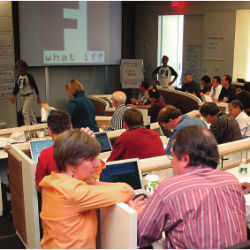
As part of its Future Internet Design initiative, the National Science Foundation (NSF) is establishing funding in 2010 for several multimillion-dollar research projects. From October 1215, 2009 at the Waterview Conference Center in Arlington, VA, the NSF held a Future Internet Architectures Summit to gain input from the research community about developing calls for proposals related to this funding. Summit organizers designed the format of the four-day event to facilitate multidisciplinary collaboration in detailing new Internet architectures built in response to emerging social and economic realities.
Altogether, the invitation-only summit drew 90 U.S.-based researchers with expertise in networking, communications, security, privacy, and the social and economic sciences. “The participants were engaged in the process and made progress toward the articulation of future network architectures,” says Ty Znati, division director for computing and network systems in the NSF’s Computer and Information Science and Engineering (CISE) division. “They also began to assemble and integrate coherent ideas and building blocks into candidate architectures.”
Znati says that while CISE is especially interested in stimulating the multidisciplinary exploration of future Internet architectures, focusing specifically on one type of architecture or network design was not a goal of the summit. “The objective was to expand the scope of research from a component-focused agenda to the design of overarching architectures for future networks,” says Znati. “It is not clear what the right architecture of future networks will be, so the summit encouraged participants to think about potential architectures from multiple perspectives.”
Objectives discussed at the event for candidate architectures were far-ranging. One proposal suggested designing networks to function in the type of infrastructure-poor environments typical of developing nations. Another suggested designing network architectures for human identity, with the idea being that communication is person- rather than device-centric. A third suggested designing a network architecture that is more connected to the physical world so that it would be capable not only of information transport, but also of control, actuation, and sensing.
“The summit succeeded in paving the way to the development of interdisciplinary communities that currently do not exist, and in fostering collaborative free thinking that otherwise would not have been possible,” says Znati.
In the end, there was no discussion about current Internet issues, such as IPv6 or Internet Corporation for Assigned Names and Numbers (ICANN) governance. “While governance will be an issue in 15 years, the current and short-term future of ICANN is not relevant,” says David Clark, a senior research scientist at Massachusetts Institute of Technology. “I don’t think anyone said ‘ICANN’ the whole time. Those are today’s arguments, not tomorrow’s arguments.”
Clark has been helping the NSF organize its Future Internet Design program, the goal of which is to envision and then design what could be the Internet of 15 years from today. “In this meeting, people had many ideas about how to make that goal more specific, but there was no desire for consensus,” he says. “This was a meeting to develop different ways of responding to that challenge.”
Following a formal report on the summit proceedings, the NSF will send out calls for proposals. The proposals will be reviewed by an expert panel, which will make recommendations with the expectation that the NSF will fund up to four projects.




Join the Discussion (0)
Become a Member or Sign In to Post a Comment